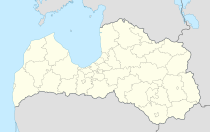Rauna (Latvia)
| Rauna ( German : Ronneburg) | ||
|---|---|---|
 |
|
|
| Basic data | ||
| State : |
|
|
| Landscape: | Livonia ( Latvian : Vidzeme ) | |
| Administrative district : | Raunas novads | |
| Coordinates : | 57 ° 20 ' N , 25 ° 37' E | |
| Residents : | 1,328 | |
| Area : | ||
| Population density : | ||
| Height : | 115 m | |
| Website: | www.raunai.lv | |
| Post Code: | ||
| ISO code: | ||
Rauna ( German Ronneburg ) is a village in northern Latvia and the center of the administrative district of the same name (Latvian: Raunas Novads ).
history
The Ronneburg was built in 1262 at the suggestion of the Archbishop of Riga Albert II. Due to its location on the trade route to Pleskau , the place was one of the most important centers of the archdiocese. In the 16th century the castle was enlarged, but the place lost its strategic importance after the Livonian War at Wenden . The castle was destroyed in the Second Northern War . Today the walls of the main building can still be seen. As chairman of the agricultural cooperative and the savings bank, the local pastor Adam Jende , who was killed by the Bolsheviks in 1918 , took care of the development of the center of Rauna in 1909.
Others
- The current Evangelical Lutheran church was built at the end of the 13th century and houses sculptures from the 14th century. Here there was a congregation of the Moravian Brethren .
- The composer, folklorist and teacher Jānis Cimze (1814–1881) was born in the Rauna community.
- Not far from Rauna on the Rauna river of the same name there is a tufa spring, called Raunas Staburags . This is the only such natural object in Latvia after the national symbol Daugavas Staburags 1965 due to the construction of a hydro-electric plant in the Daugava River sank.
Raunas novads
The municipality was supposed to come to the Priekuļi district as part of an administrative reform in 2009, but instead formed an administrative community with Drusti, although the two municipalities are not directly adjacent. (See also: Administrative division of Latvia )
literature
- Hans Feldmann , Heinz von zur Mühlen (Hrsg.): Baltic historical local dictionary, part 2: Latvia (southern Livland and Courland). Böhlau, Cologne 1990, ISBN 3-412-06889-6 , pp. 517-518.
- Astrīda Iltnere (ed.): Latvijas Pagasti, Enciklopēdija. Preses Nams, Riga 2002, ISBN 9984-00-436-8 .


